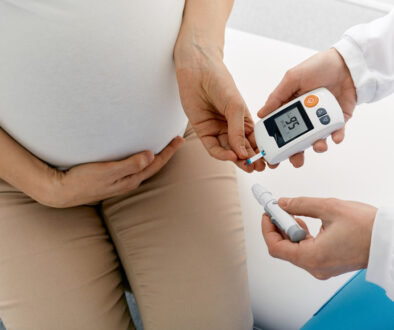What Is Preeclampsia? Vital Facts You Need To Know

In this article:
We care about the health and well-being of our obstetric patients at every phase of their pregnancies. Some may be interested to know more about a condition called preeclampsia, particularly if they have any preeclampsia risk factors or symptoms of preeclampsia.
For decades, we’ve served patients throughout the Dallas area, continuing our tradition of offering comprehensive, compassionate and state-of-the-art care. We invite you to schedule an appointment with us to experience our patient-centered practice.
What Is Preeclampsia and How Common Is It?
Preeclampsia is a progressive disease affecting 5% to 8% of pregnancies with different levels of severity. Features include:
- High blood pressure during pregnancy
- Impairment of the:
- Brain
- Liver
- Kidneys
Preeclampsia occurs mostly in pregnancies after 20 weeks of gestation, but it may also occur in the postpartum period. When diagnosed and managed in a timely manner by a healthcare provider, outcomes are usually excellent, and the disease slowly resolves after delivery.
What Are The Causes of Preeclampsia?
It is important to know that preeclampsia occurs due to complicated physiological events that physicians cannot entirely prevent, and you, as a patient, will not get preeclampsia because of anything that you did, for instance, not taking your vitamins, or eating the “wrong foods.”
What Are The Preeclampsia Risk Factors?
Risk factors associated with a higher chance of developing preeclampsia, or high blood pressure during pregnancy, include:
- First pregnancy
- Chronic hypertension
- Multiple gestation such as twins
- Pre-existing kidney disease
- Diabetes
- Autoimmune diseases such as lupus.
Minor risk factors are:
- Maternal age greater than 40 or less than 20 years
- Family history of preeclampsia
- Being overweight (body mass index greater than 30)
- Having polycystic ovarian syndrome
- Having sleep apnea
How Does Preeclampsia Begin?
The origin of preeclampsia is complex, but it is believed to begin with the development of the placenta early in pregnancy.
A portion of placental cells must invade the uterine wall and this allows the remodeling and modification of the uterine vessels, which must occur for the placenta to bring oxygen and nutrients to the baby. In a patient destined to develop preeclampsia, this remodeling does not occur to the extent that it should. The placental functions are then diminished.
In addition, the placenta begins to produce chemical mediators, which are released into the circulation. These substances cause vasospasms, narrowing and causing severe injury to the small to medium arteries that supply the uteroplacental unit as well as the maternal kidneys, liver and brain.
The resulting decrease in blood flow to these organs causes impairment in their functions and hypertension is also usually present. The decreased blood flow to the brain can result in maternal seizures. The decrease in blood flow to the placenta can put the baby’s health at risk.
Challenges of Diagnosing Preeclampsia
Although we, as obstetricians, are trained to be vigilant in recognizing preeclampsia during a patient’s office visits, it can sometimes be tricky to diagnose.
We look for an increase in blood pressure, obtain blood and urine tests that can help us know if the liver and kidney functions have been affected and ask about whether any symptoms of preeclampsia have occurred.
We often will use ultrasounds to monitor the well-being of the fetus, and will ask patients if they have experienced any preeclampsia symptoms.
What Are the Symptoms of Preeclampsia?
We would like to educate you about preeclampsia symptoms and encourage you to report these symptoms to us if they occur:
- Severe headache that is not relieved with Tylenol or rest
- Extreme fluid retention, particularly in the hands and face
- A rapid weight gain, several pounds in a few days, often from retaining excess fluid
Less common symptoms include:
- Severe right upper quadrant pain (in the area where the liver is located)
- Shortness of breath at rest
- Severe nausea and vomiting
- Defects in the visual field (spots in your vision)
It is important to remember that many of these symptoms occur in perfectly normal pregnancies and are not, in themselves, necessarily diagnostic of the disease.
What Are the Treatments for Preeclampsia and How Is It Managed?
Delivery is said to be the “cure” for preeclampsia, and it usually halts disease progression and allows a return to normalcy over time.
The main goal of preeclampsia management is to try to modify its progression and monitor the health of the mother and fetus until the fetus is mature enough to be delivered, and to hopefully avoid the consequences of severe prematurity.
How to Manage Preeclampsia
Each patient is different, and our doctors must consider how far along the pregnancy is and how sick the patient is. Fortunately, many patients with mild disease can be managed by bed rest at home (or in the hospital if necessary), with frequent testing to be sure the disease is not worsening.
Delivery can then take place a few weeks before the due date, either by induction of labor or by caesarean section if there is a reason to perform one. During the labor process, medication is given to control hypertension and prevent seizures.
In cases where there is rapid disease progression prior to optimum fetal age for delivery, or severe high blood pressures are noted and cannot be controlled, the physician’s judgment may be that the preeclampsia is life-threatening, and poses a greater risk for the mother and fetus than the risks of prematurity.
It is in these cases that the baby may have to be delivered early. Fortunately, great advancements have been made in the care of the premature infant, and many of these babies ultimately survive and do very well.
Let Us Help You Manage Your Pregnancy to Evaluate Your Risk of Preeclampsia
Preeclampsia can be successfully managed and controlled, but it is vital to be diligent and aware of the warning signs of this disease. As leading OBGYNs in Dallas, we understand the challenges our patients face, and we’re dedicated to helping them through every step of their journey.
Whether you’re planning to conceive or you’re having your third child, we want to be a partner in your care. Please contact us for an appointment.
Key Takeaways:
- Preeclampsia is a progressive disease that can feature different levels of severity.
- Preeclampsia can be difficult to diagnose, so a patient’s medical history and symptoms must be carefully monitored.
- Preeclampsia can manifest itself with:
- High blood pressure
- Brain impairment
- Liver problems
- Kidney impairment
- Preeclampsia affects 5% to 8% of all pregnancies.
- If untreated, preeclampsia can have serious implications for the mother and place her at greater risk of having a premature delivery.
- When caught early and managed properly, those with preeclampsia have a good prognosis for both mother and baby.
The content within this article and others on this website is only for educational purposes and should not be considered medical advice. For any questions or concerns, please consult with your healthcare provider.
====
Sources:
Cleveland Clinic, “Preeclampsia,” https://my.clevelandclinic.org/health/diseases/17952-preeclampsia




